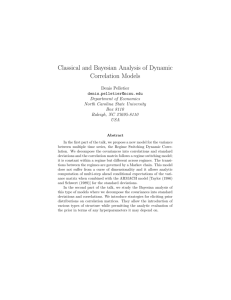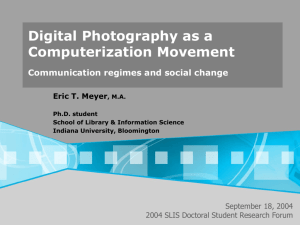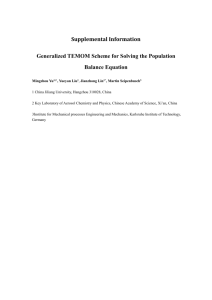International Portfolio Optimization using Regime Switching
advertisement
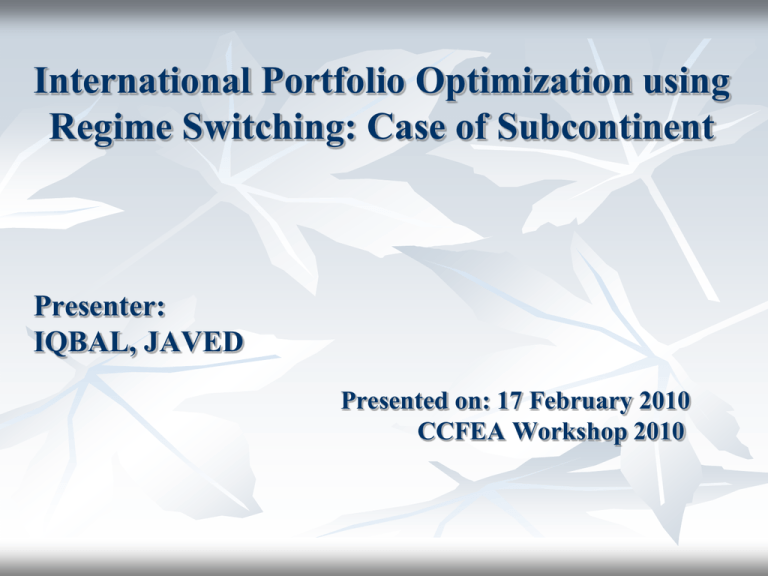
International Portfolio Optimization using
Regime Switching: Case of Subcontinent
Presenter:
IQBAL, JAVED
Presented on: 17 February 2010
CCFEA Workshop 2010
Structure of our Presentation
Introduction:
What is Regime Switching
(RS)
Stylised facts and brief
Literature Review
Methodology:
The Capital Asset Pricing
Model (CAPM)
Maximum Likelihood
Estimation
Data Description & Analysis
Descriptive Statistics
RS model without Short
Selling
RS model with Short Selling
Conclusion
Q&A
What is Regime Switching?
“Formally Regime Switching models refer
to a situation in which stock market returns
are drawn from two different distributions,
with some well defined stochastic process
determining the likelihood that each return
is drawn from a given distribution”
Newmann (1997).
Examples of Regimes
Exchange rates have periods of appreciation and
depreciation vis-à-vis other currencies.
Economic business cycles have boom and bust
periods.
Equity markets are characterized by bull and bear
markets.
Asset prices also have prolonged periods of upward
movement followed by downward movements.
Brief History of Regime Switching
Models
and Literature Review
Markov Switching Models (MSM), go back as
far as Quandt(1958), Goldfeld and Quandt
(1973)
Hamilton (1989) extended MSM to dependent
data using GARCH models on GDP data
RS models have subsequently extended to
other areas of finance and economics, for
example in Asset allocation (Ang and Bekaert,
2002), Government spending (Nelson 2003),
Levels of mergers and acquisition, energy
market spot prices, interest rates and exchange
rates.
Stylised facts of asset pricing
Stylised facts of asset returns show that during bull markets
and bear market returns, volatility and correlations behave
differently.
In the latter, returns are lower, volatility is higher, and asset
correlations increases. A phenomenon known as Asymmetric
Correlation.
Ang and Bekaert (2002) concluded that there was significant
evidence of Asymmetric correlation. Correlation between
these assets tended to be higher when there were market
downturns. On average they were 20% higher than in the
normal regime. They statistically rejected at 0.01%
significance the equality of volatility across regimes.
Hess (2006) reported volatility in turbulent times, can be 2.2
times higher than in calmer periods
Stylised facts of asset pricing (contd..)
Recent studies confirm that the conditional moments
of stock returns are business cycle related, this results
in the distribution of stock market returns to be timevarying, (Hess, 2006). Therefore the optimal portfolio
in bear markets is substantially different from the one
in bull markets.
Ang and Bekaert (2004) noted that the presence of
asymmetric correlation has raised doubts about the
benefits of diversification especially in market
downturns.
Why International Indices?
Globalization
Diversification of Risk
International integration has caused
correlation to go high but variance of foreign
portfolios declined giving a rationality to
invest in foreign markets (Karen, 2006).
Co-movement in troubled times has
increased especially in troubled times (Flavin
and Panopoulou, 2006).
(contd..)
For example, during periods of high U.S.
variance, foreign markets become highly
correlated with the U.S. market. This has
considerable affect on the formulation of
portfolio
diversification
strategies
(Ramchand and Susmel, 1998).
Assoe (1998) showed that emerging
markets go through two regimes whether
the market returns are expressed in
respective local currencies or in U.S.
dollars.
(contd..)
Ang and Bekaert (1999) concluded that “the
costs of ignoring regime switching are small
for moderate levels of risk aversion;” whereas
Das and Uppal (2004) state that “there are
substantial differences in the portfolio weights
across regimes.”
Methodology
Methodology
To model regime switching, we adopt a model similar to that used by Ang & Bekaert (2004)
and Markose & Yang (2008).
The CAPM assumptions are assumed to be satisfied
The CAPM equation is:
rit i i rmt it
rit =
rmt
excess return on security i for a given period, at time t
= excess return on market index for a given period, at time t
= intercept term
i
i
i
=slope term
N 0,1, iid
Total risk of security i,
2 measured by its variance equals the following:
i
2
i
m2
i2
i2 m2
2
i
2
m
2
i
= variance of returns on the market index.
Specific/ idiosyncratic risk. As this risk can be eliminated through
diversification, this risk is not rewarded.
Systematic / Market risk, this is the proportion of total risk that
is priced, it is un diversifiable.
The state dependent model is thus affected by the
regime via the market index realised regime,
according the markov chain rule
rmt m (st ) m (st ) mt
st
denotes the regime variable whose value depends on regime
realization (1 or 2) of market index,
m (s t )
( st )
m
denotes the regime-dependent mean of excess return on market index
denotes the regime-dependent conditional volatility, measured by
standard deviation.
THE CONDITIONAL TRANSITION
PROBABILITIES (MARKOV CHAIN RULE):
PARAMETERS TO ESTIMATE:
θ = {µ1, µ2, σ1, σ2, P, Q}
the filter probability (ex-ante probability)
Regime Probability which is the inference about the process
being in some particular regime at time t basis on the
information available at time t;
the smoothed probability (ex-post probability)
The smoothed probabilities are the interference about the
historical regimes the process was in at some point t. and it is
based on the full sample information.
METHOD: MAXIMUM LIKELIHOOD
Hamilton (1989) offers an approach on how to model
regime changes when the shifts are not directly
observable but statistically inferred through observing
the behaviour of the series.
In the two state RS model, we assume the model is
drawn from two normal distributions and the mean,
variance, correlations are state dependent. The
conditional density function for rmt (St), St =1, 2:
f rmt st , rmt 1
T
L {θ} =
2
t 1 s 1
st
2
r
1
mt
st
exp
2 st
2
st
2 2 st
1 (rmt st ) 2
. exp
st
2
t1
1 f
1 f
r
mt
r
mt
st 1, rt 1
st 1, rt 1 2 f
r
st 2, rt 1
mt
and
t2
1 f
r
mt
P 1*
2 f
r
mt
st 2, rt 1
st 1, rt 1 2 f
1
T
T
t 1
t1
r
mt
st 2, rt 1
1
Q 2*
T
(1)
T
t 1
t2
(2)
*
m1
2*
m1
1
T
t1
rmt
*
t 1
1
T
2
1 T t1
* rmt 1*
T t 1 1
and
and
*
m2
2*
m2
1
T
T
t2
t 1
*
2
rmt
2
1 T t2
* rmt 2*
T t 1 2
(3)
(4)
We iterate the process in (1), (2), (3) and (4)
till the values for П1*, µ1* and б1, for state 1
and 2 stabilize.
DATA DESCRIPTION AND
ANALYSIS
Data Analysis & Description
1.
2.
Data used is monthly index values for three Subcontinent
stock Exchanges from December 1993 to July 2009. These
stock indices are Karachi Stock Exchange (KSE), Bombay
Stock Exchange (BSE) and Dhaka Stock Exchange (DSE).
The MSCI World is used as the market index, a proxy of
GDP. It is generally accepted that that business cycles drive
regimes in the stock market, (Markose and Yang, 2007)
The monthly US T-Bill Rate is used as the risk free return, to
facilitate the calculation of excess returns.
The sample period is December 1993 to July 2009, totalling
185 observations for each stock index.
In Sample 1994-1999
Out of Sample 2000-2009
Statistical Description of Three Indices : Whole Data
Observations:
Descriptive Statistics
Mean
Variance
Std Deviation
Excess Kurtosis
Skewness
OLS Regression
Intercept
Slope
Covariance Matrix
BSE
DSE
MSCI
Correlation Matrix
KSE
BSE
DSE
MSCI
Whole Sample : January 1994 -July 2009
185
KSE
BSE
DSE
0.007736718
0.007078312
-0.00052467
0.010660245
0.007738875
0.006075785
0.10324846
0.087970877
0.077947321
5.915471363
0.088971547
2.56534842
MSCI
0.00297923
0.002058534
0.045371066
2.771351387
-1.27637547
-0.38747051
-0.029437787
-1.107038957
0.002112
0.058243
0.002359
0.035381
0.003919
0.254823
0.010602622
0.002289254
0.001142067
0.000176949
0.002289254
0.007697043
0.000444839
0.000174339
0.001142067
0.000444839
0.005968859
0.001548014
0.000176949
0.000174339
0.001548014
0.002047525
1
0.253410925
0.142104097
0.037964878
0.253410925
1
0.064962548
0.043901024
0.142104097
0.064962548
1
0.438943673
0.037964878
0.043901024
0.438943673
1
Regime Estimates and Transition
Probabilities
Regime 1
Regime 2
Transition Probability
µ1
σ1
µ2
σ2
P
Q
Estimat
es
0.37
1.75
-3.13
4.27
0.9814
0.5501
Standar
d Error
0.0012
0.0237
0.0010
0.0098
0.0166
0.2391
Data Analysis & Description (Contd..)
In addition to the parameters reported in Table 1, the model
can also infer the Regime probabilities i.e.
1. filter probabilities and
2. smoothed probabilities.
The filter probabilities indicate the process being in some
particular regime at time t based on the information available
at the time t-1.
In contrast to filtered probabilities, the smoothed probabilities
indicate the historical regimes the process was in at time t
based on whole sample information and are calculated
backwards by using filter and forecasting probabilities
Smoothed vs. Filtered Probabilities
Monthly Portfolio Optimization
To test the regime switching portfolio
optimization and its performance over the out
of sample period (6 years), we used the
following three strategies:
1.
2.
3.
Regime switching (RS) mean-variance
optimization
Non-RS mean-variance optimization
Market capitalization weights portfolio
Monthly Portfolio Optimization
(Contd.)
1 GBP initial investment in the out-of-sample data
starting from Jan 2000.
By using the actual prices on the following month,
we calculated the returns and all the profits were
reinvested into the three portfolio strategies.
The three different strategies were further divided
on the basis of
1.
2.
Short selling approach and
No short selling approach
Accumulated Wealth with No Short-Selling
No Short-Selling Approach (Contd)
These properties suggest that regime switching portfolio
optimization would benefit from actively rebalancing portfolio
weights and would capture effectively the changing trends of
equity market. Hence, RS strategy can be proved as forward
looking as compared to other two strategies which are
backward looking (relying on past events after they have
happened).
Accumulated wealth with Short-Selling
Short-Selling Approach (Contd..)
Since there is no restriction on short selling,
the portfolio weights can go negative or above
1. In this case, RS strategy enjoys more
flexibility and utilises its capability to infer
about regimes and taking the right advantage
of its forward looking behaviour.
Conclusion
Shown evidence of RS in equities market, empirically and analytically
Results shows: µ1> µ2, σ1< σ2.
On average regime 1 expected return and standard deviation are .37% and 1.75%
per month respectively, while for regime 2 these values are -3.13% and 4.27% per
month.
Evidence of regime persistence especially for the stable regime, P=0.9818
£1 invested in active RS portfolio outperformed non-RS and market capitalisation
strategies. Expected returns from RS strategies vs. non-RS in all scenarios, on
average you would expect to get 50% more on average from applying dynamic RS
strategies!!
There were large market timing benefit which were more prominent when we
included a risk free asset in to the portfolio and for the risk lover
RECOMMENDATIONS
Our model omitted transaction costs, these will significantly impact the
profit especially when we consider monthly rebalancing applied in our
model
Since there is evidence of regime persistence ARMA models may be
considered and compared against the CAPM framework
Although it is a simple model with 2 regimes and 3 assets, the RS model
incorporated in this study can be extended to multiple regimes and assets
The value of Beta has been shown to vary, for example when we looked at
the post dotcom bull or bear scenario. Further areas of research in this area
may consider including time varying beta.
Q&A


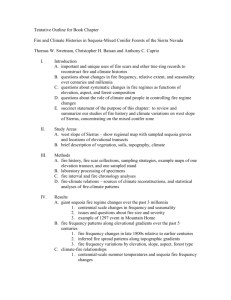
![Understanding barriers to transition in the MLP [PPT 1.19MB]](http://s2.studylib.net/store/data/005544558_1-6334f4f216c9ca191524b6f6ed43b6e2-300x300.png)
